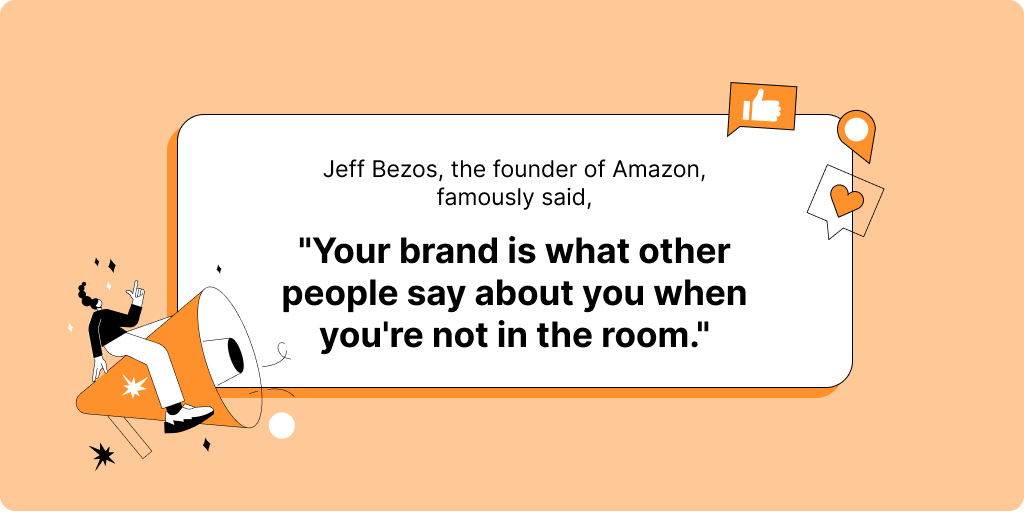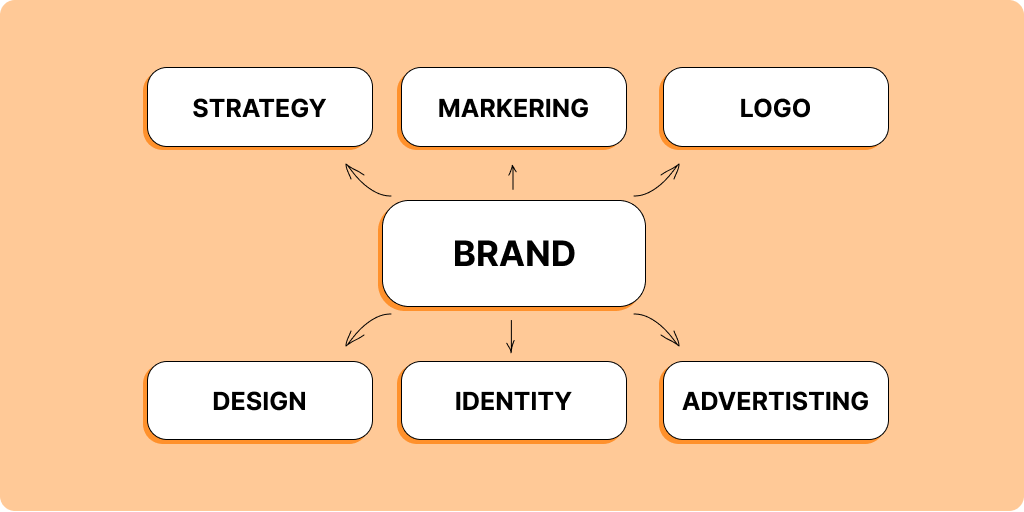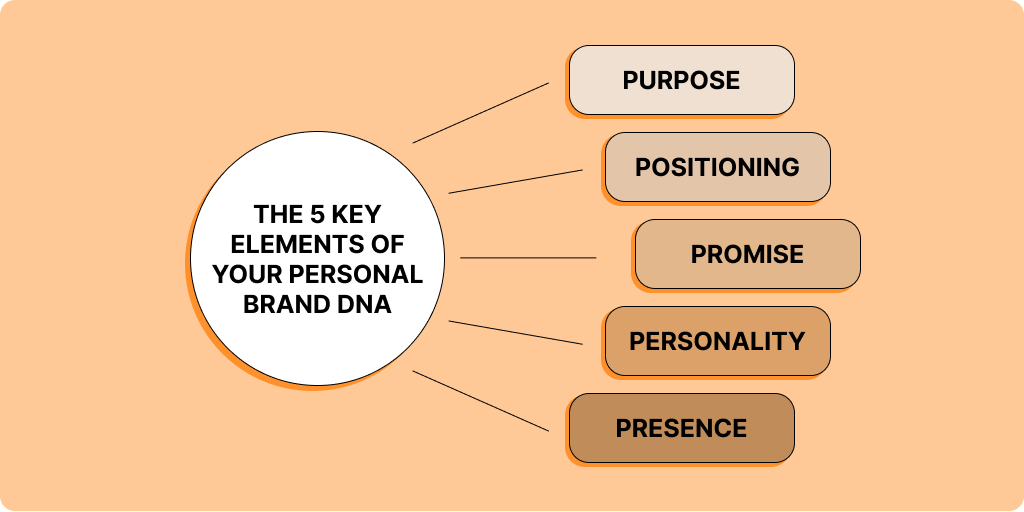The most powerful brands stand out, distinct and unique, while weaker ones merge together like an indiscernible mass. Still, there’s a common bond that ties all strong brands together. By observing influential brands and creators, we’ve identified the traits that lead to success, capturing the essence of their excellence. In this blog post, we aim to share these valuable habits, inspiring you to build an outstanding brand and elevate your content business to new heights.
So, what exactly is a brand?

It’s not merely a name, logo, or tagline. Rather, it’s the perception and emotional connection that people form with your company, products, or services. Jeff Bezos, the founder of Amazon, famously said, “Your brand is what other people say about you when you’re not in the room.” A powerful brand has the ability to take your content from informative to unforgettable.
Consider the remarkable case of TED Talks, a global platform for sharing innovative ideas through short, impactful presentations. TED’s consistent branding – from its signature red logo to its thought-provoking content – has made it a household name in the world of education and inspiration.
Now, one may ask, “How can a company sell well for years and still lack a brand?” The answer is simple: there are countless needs to be met in the world, and if you offer a product or service that satisfies these needs, people will buy from you. However, if you aspire to play in the big leagues, you need to focus on building a brand. In Sweden, a study conducted among the 260 largest companies found that brand-driven businesses generated, on average, 100% more profit than those that did not prioritize branding.
What sets strong brands apart from the rest
Know Your Target Audience
The first step in creating an effective brand is identifying your target audience. Who is the person you created this product for? The key to success lies in the ability to use your imagination to fully envision your ideal customer. Avoid being vague and general in your approach. The more specific and precise your description, the easier it becomes to understand how to connect with them through your product or service.
Different advertising agencies may have their own tools and techniques for defining a target audience. Typically, you begin by gathering information, almost like an FBI agent compiling a dossier. From there, you move on to more abstract characteristics such as personality, tastes, and hobbies.
Consider what obstacles your ideal customer faces, what keeps them up at night, and what they dream of achieving. Envision where they see themselves in five years, whom they aspire to be like, and what they detest or remain indifferent to. The more you understand your target audience, the more effectively you can tailor your brand to resonate with their desires and aspirations.
Know Your Foe
Many influential brands identify a powerful enemy to rally against, using their communications to wage a metaphorical crusade. This adversary should be formidable, as a weak opponent hardly inspires a compelling struggle. In essence, successful brands recognize their enemy and seek to defeat them.
Consider Nike, an exceptional brand with an enemy best described as “sitting idly by.” Indeed, numerous life challenges stem from inactivity, including laziness, apathy, and self-doubt that breeds indifference. For years, Nike has combated these foes, inspiring us to take action. Apple, another iconic company, began building its brand by declaring war on an enemy characterized as “conformity.” With their famous slogan “Think Different,” Apple urged us to be the outlier, the black sheep daring to defy the herd.
Harness the Power of Feedback
To optimize your business and ensure continued growth, it’s essential to identify both the positive aspects and areas in which there is room for improvement. Equally important is gauging the satisfaction levels of your employees and customers. In the realm of marketing, customer perceptions of your brand can make or break your strategy. While creating client personas can be helpful, the most reliable source of feedback comes directly from your customers.
Conducting customer surveys and soliciting feedback, both positive and negative, is crucial. Embrace the negative input and use it as an opportunity for growth. Don’t be afraid to ask for feedback, as it can be invaluable to the success of your business. Remember, feedback is a gift that allows you to enhance your brand and better serve your customers.
Recognize What Makes You Different

People inherently seek out individuality, even in inanimate objects. This concept underpins the idea of brand identity. When we talk and think about brands, we use human criteria. Just as we are not drawn to ordinary, unremarkable people, we are not drawn to brands that lack personality. We are unlikely to invite someone without a sense of humor to our home, as there’s little to discuss beyond work. Similarly, we wouldn’t purchase jeans from a brand lacking a unique perspective and voice, even if they advertise “quality denim.”
Every brand needs a “nose” – that special something that sets it apart. Without a distinct identity, brands blend into the background. Carl Rogers refers to individuals as “fully functioning persons.” This applies equally to brands. By acquiring a unique identity, a brand gains a sense of purpose and direction, allowing it to truly come to life.
Fail Forward
There are excellent brands, and then there are iconic brands like Reebok and Nike. Iconic brands create the new, shaping their symbols, language, and unique identity from scratch. Such innovative branding cannot be found in textbooks; it must be created. To achieve this level of success, one must be willing to risk failure.
Reebok is a solid brand because it tries to keep up with trends, attempting to make its mark. However, it always falls short and remains in the shadow of true icons. While Reebok does everything by the book, it still struggles to stand out. Trying to keep up with the competition will always leave you a step behind.
On the other hand, Nike is an iconic brand because it doesn’t try to match anyone or anything. It has faith in its unique identity and vision, even if it deviates from conventional norms. Nike’s ability to innovate, take risks, and move beyond its comfort zone has made it an icon in the industry. The lesson here is clear: don’t be afraid to make mistakes. In fact, failing forward is often the key to unlocking your brand’s true potential. By taking risks and breaking the rules, you can set your brand apart and reach the level of iconic status.

Most people and organizations focus solely on the “what” and “how” of their actions. However, true leaders and success stories in history are the ones who think about the “why.”
The “why” of your brand is the driving force behind what you do. It’s your purpose, your cause, your belief, or your motivation – the reason for your business’s existence beyond just making money. When you understand your “why,” you can inspire action and set yourself apart from your competition. The “how” of your brand, also known as your mission, is the unique process you use to achieve your purpose. It’s what makes you unique and sets you apart from others. This could be your strengths or values that define who you are as a brand.
Finally, there’s the “what” of your brand, also known as positioning. This is the outcome of your actions – the proof of your existence and the products or services you offer. It’s your position in the market and the value you provide to your customers. This approach, called the Golden Circle, is used by the world’s top companies to define their brand’s purpose, mission, and positioning. By starting with “why,” you can clarify your vision and inspire others to take action, creating a unique and successful brand.
Find Your Gap
In today’s business world, strategy is everything. Simply creating a good product or service is no longer enough. The brand that finds its unique position in the market wins, even if its product is ordinary. All the popular niches have been taken, but there are always those that have been overlooked or deemed too simplistic. It may be time to take a closer look at those niches. Consider the example of the Volkswagen Beetle, which was introduced in 1959 during the era of big, flashy cars. The “Big Three” American car manufacturers – Chrysler, General Motors, and Ford – dominated the market. Then came the small, chubby, and unattractive Volkswagen Beetle.
Instead of trying to hide its flaws, Volkswagen’s advertising agency DDB took a bold approach and launched a campaign with the slogan “Think Small”. This campaign successfully positioned the Beetle as a counter-culture icon and challenged the prevailing notion that bigger was always better. This ad campaign remains one of the most effective in Volkswagen’s history, with the Beetle becoming the first car to be purchased 20 million times. Volkswagen found its niche so well that it became a cultural icon for a whole generation. While there were other small cars on the market, none of them dared to say “being small is cool.” Volkswagen was the first to carve out its unique position in the market.
Be Consistent
To build a strong brand identity and increase brand awareness, consistency is key. Your potential customers won’t be able to understand your company’s values if your branding strategy varies across different channels. So, how do you achieve consistency in branding? The first step is to create explicit brand guidelines and standards for your visual and written communications. This will ensure that your focus remains intact while launching fresh campaigns.
To keep your branding messages consistent, all your channels need to be in sync. From your website to Instagram, Facebook, Twitter, and more, you need to maintain a consistent message. Defining your brand voice is an essential step in maintaining consistency. What are the essential characteristics that you want to convey to your audience? Creating a brand voice that captures the attention of your ideal customers is critical.
Your colour palette is another important aspect of your branding. Choosing a primary colour and 3 or 4 complementary tones for a secondary palette can help keep your visual assets consistent but not repetitive. Maintaining brand colour consistency will aid in brand identification. Logo design also plays a critical role in branding consistency. Establish rules for how you want your logo to appear in various formats. Include colour variants and guidelines for vertical and horizontal formatting.
Typography matters. Brands usually have a primary font and a secondary font that is used for titles, paragraph content, and captions, respectively. Using consistently branded fonts, similar to your colour palette, can help in brand recognition. Consistency is critical in building a strong brand identity. Establishing brand guidelines and standards for your visual and written communications, maintaining a consistent message across all channels, and using consistent branding elements like logo design, colour palette, and fonts will help you achieve this.
Nail Your Strategy in a Nutshell
A strong brand can describe its strategy to you during a quick elevator ride to the third floor. They won’t need to stop the elevator, whip out a laptop, and present a long and complex PowerPoint presentation. Instead, their strategy will be simple, concise, and memorable. You’ll be eager to see their next advertising campaign because you’ll know exactly “what will be said” and be curious about “how it will be said.”
Understanding your brand’s strategy in a nutshell is essential for effective and consistent communications. Without a clear and concise strategy, advertising campaigns can become chaotic and ineffective, leading to wasted resources and missed opportunities. So, make sure you can nail your brand’s strategy in a nutshell, and watch your communications soar.
Prepare for a Marathon, not a Sprint
Building a successful brand takes time and requires a long-term commitment. A strong brand strategy is not created overnight, but through careful planning, execution, and adaptation. Great brands understand that branding is an ongoing process that lasts as long as the brand exists.
To ensure the growth and success of your brand, it’s important to embrace long-term planning. Your branding efforts should not be limited to short-term goals. Instead, continually refine your brand strategy, taking into account your long-term objectives and changes in the market. By doing so, you can ensure that your brand remains relevant, engaging, and effective for years to come. Remember, building a powerful brand is a marathon, not a sprint.
To sum up
Building a strong brand takes time, effort, and commitment. It requires a thorough understanding of your target audience, competition, and unique position in the market. By following the ten tips outlined in this article, you can create a powerful and memorable brand that resonates with your audience and stands out in a crowded market.
Remember to start by understanding your “why” and using it to inspire action and set yourself apart from the competition. Use feedback to optimize your business and find your unique gap in the market. Once you’ve defined your brand’s identity, maintain consistency across all channels with brand guidelines, visual and written communications, logo design, color palette, and fonts.
Finally, be prepared for the long haul. Building a strong brand is a marathon, not a sprint. Continuously refine your brand strategy, taking into account your long-term objectives and changes in the market. By doing so, you can ensure that your brand remains relevant, engaging, and effective for years to come. And if you’re looking for tools to help you build your branded platform and monetize your expertise, consider signing up for Trible. With our powerful platform and inspirational community of creators, you’ll have everything you need to build a strong brand, connect with your audience, and take your content business to the next level!
 Open Sesame: 225 Engaging Email Subject Lines + Crafting Tips
Open Sesame: 225 Engaging Email Subject Lines + Crafting Tips







